In a right triangle, if one leg is 5 units long and the other leg is 12 units long, what is the length of the hypotenuse?
13 units
17 units
19 units
29 units


The right triangle is a very distinct triangle that has the special characteristic property of having all equal angles inside the triangle. This type of triangle is the most famous of the three types of triangles. One of the best ways to know the overall length and area of a right triangle is through the usage of the Pythagorean Theorem.
The Pythagorean theorem is a proven solution that allows the person to calculate the area of each square that a line will represent on each side of the triangle. The Pythagorean theorem states that the summation of the squares of both of the smaller sides is equal to the square of the hypotenuse. This theorem has many applications in different contexts, themes, and practical situations, such as construction and architecture. This theorem has a lot of place in history and has origins that trace back to the Greeks culture, ethnicity, ethnic group, and subculture of mathematicians.
The Pythagorean theorem follows a very simple outline or outline format that people can easily use to obtain and generate missing information about a right triangle. If you want to learn more about how to use and solve the Pythagorean theorem, you can opt to look at any of the articles, examples, or math worksheets for students on the links above.
Begin by obtaining or familiarizing yourself with the Pythagorean theorem as this will help provide a suitable structure and starting point you can use to create a solution. Not only that but it will also provide you with the variables you need to identify in the problem or question. The Pythagorean theorem is A^2 + B^2 = C^2 where A and B are the shorter lines and C is the hypotenuse.
You must write down or separate the variables that you will use in the questions as this will help you easily substitute the correct values to the variables. You must also ensure that all variables have the same measurements. If they don’t, you must convert them accordingly.
When you have finished writing down the specific variables, you but now substitute them to the formula of the Pythagorean theorem. Ensure that the missing variable is situated on the left side of the equation, this means you will do the specific operations to transfer the variable if it is needed.
When you have finished substituting all the variables in the formula, you must solve for the missing variable. You must also ensure that the answer has the correct mode of measurement the question has asked of you. If it is not, then you must convert it accordingly.
No, they cannot. The Pythagorean theorem is a specific formula that people can only apply to right triangles exclusively. This means people cannot use the formula to solve for specific areas or lengths of the sides of an obtuse triangle.
No, a person cannot use the Pythagorean theorem to solve for specific lengths and areas on acute triangles. The Pythagorean theorem can only solve for areas or lengths of each side of right triangles.
The Pythagorean theorem owes its namesake to the Greek philosopher or mathematician who postulated the formula. Pythagoras is a Greek philosopher who lived from 570 – 495 BC, he did not only formulate the Pythagorean theory, but Pythagoras also posited the idea of the sphericity of the Earth.
The Pythagorean theorem is a specific and specialized formula people can use to identify the specific lengths and areas of the sides of a right triangle. It is important to know and understand the Pythagorean theorem and its modern-day applications.

The right triangle is a very distinct triangle that has the special characteristic property of having all equal angles inside the triangle. This type of triangle is the most famous of the three types of triangles. One of the best ways to know the overall length and area of a right triangle is through the usage of the Pythagorean Theorem.
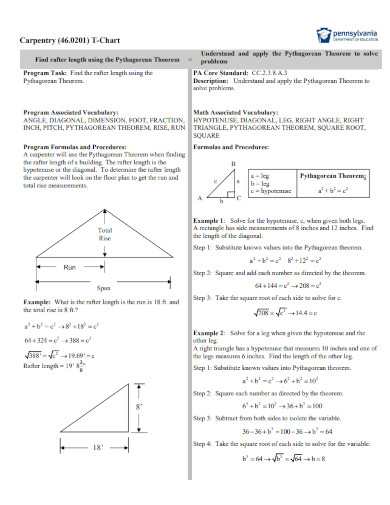
education.pa.gov
Details
File Format
Size: 63 KB
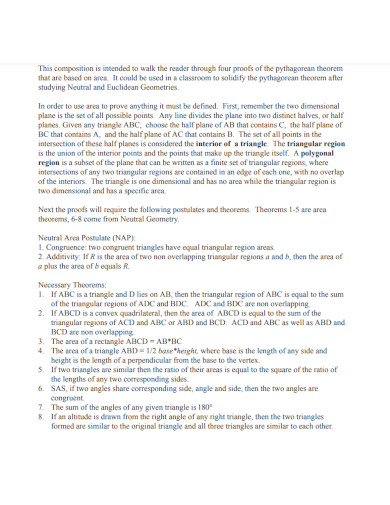
scholarworks.boisestate.edu
Details
File Format
Size: 64 KB
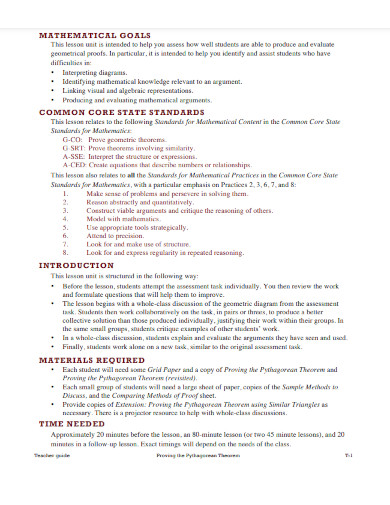
map.mathshell.org
Details
File Format
Size: 76 KB

bridgeportschools.net
Details
File Format
Size: 24 KB
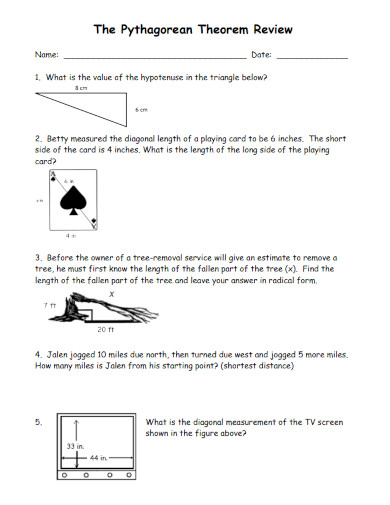
kyrene.org
Details
File Format
Size: 43 KB

site.uottawa.ca
Details
File Format
Size: 31 KB
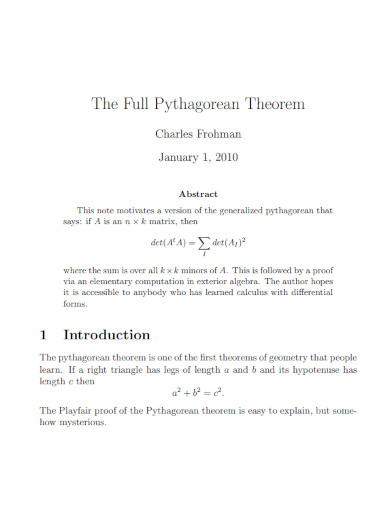
homepage.divms.uiowa.edu
Details
File Format
Size: 34 KB
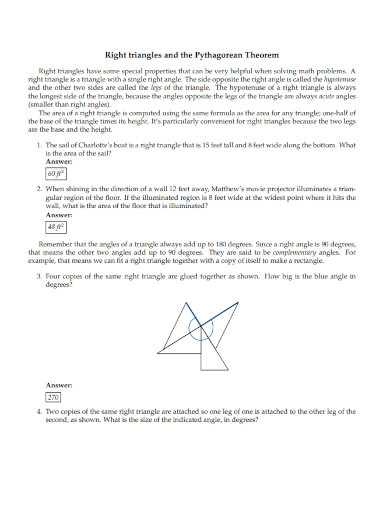
cs.cornell.edu
Details
File Format
Size: 52 KB
The Pythagorean theorem is a proven solution that allows the person to calculate the area of each square that a line will represent on each side of the triangle. The Pythagorean theorem states that the summation of the squares of both of the smaller sides is equal to the square of the hypotenuse. This theorem has many applications in different contexts, themes, and practical situations, such as construction and architecture. This theorem has a lot of place in history and has origins that trace back to the Greeks culture, ethnicity, ethnic group, and subculture of mathematicians.
The Pythagorean theorem follows a very simple outline or outline format that people can easily use to obtain and generate missing information about a right triangle. If you want to learn more about how to use and solve the Pythagorean theorem, you can opt to look at any of the articles, examples, or math worksheets for students on the links above.
Begin by obtaining or familiarizing yourself with the Pythagorean theorem as this will help provide a suitable structure and starting point you can use to create a solution. Not only that but it will also provide you with the variables you need to identify in the problem or question. The Pythagorean theorem is A^2 + B^2 = C^2 where A and B are the shorter lines and C is the hypotenuse.
You must write down or separate the variables that you will use in the questions as this will help you easily substitute the correct values to the variables. You must also ensure that all variables have the same measurements. If they don’t, you must convert them accordingly.
When you have finished writing down the specific variables, you but now substitute them to the formula of the Pythagorean theorem. Ensure that the missing variable is situated on the left side of the equation, this means you will do the specific operations to transfer the variable if it is needed.
When you have finished substituting all the variables in the formula, you must solve for the missing variable. You must also ensure that the answer has the correct mode of measurement the question has asked of you. If it is not, then you must convert it accordingly.
No, they cannot. The Pythagorean theorem is a specific formula that people can only apply to right triangles exclusively. This means people cannot use the formula to solve for specific areas or lengths of the sides of an obtuse triangle.
No, a person cannot use the Pythagorean theorem to solve for specific lengths and areas on acute triangles. The Pythagorean theorem can only solve for areas or lengths of each side of right triangles.
The Pythagorean theorem owes its namesake to the Greek philosopher or mathematician who postulated the formula. Pythagoras is a Greek philosopher who lived from 570 – 495 BC, he did not only formulate the Pythagorean theory, but Pythagoras also posited the idea of the sphericity of the Earth.
The Pythagorean theorem is a specific and specialized formula people can use to identify the specific lengths and areas of the sides of a right triangle. It is important to know and understand the Pythagorean theorem and its modern-day applications.
Text prompt
Add Tone
10 Examples of Public speaking
20 Examples of Gas lighting
In a right triangle, if one leg is 5 units long and the other leg is 12 units long, what is the length of the hypotenuse?
13 units
17 units
19 units
29 units
If the hypotenuse of a right triangle is 30 units and one of the legs is 24 units, find the length of the other leg.
18 units
20 units
22 units
24 units
A right triangle has a hypotenuse of 50 units and one leg of 30 units. What is the length of the other leg?
30 units
40 units
50 units
60 units
In a right triangle, if the hypotenuse is 13 units and one leg is 5 units, what is the length of the other leg?
12 units
13 units
14 units
15 units
A right triangle has one leg measuring 7 units and the hypotenuse measuring 25 units. Find the length of the other leg.
21 units
22 units
23 units
24 units
If the legs of a right triangle are 8 units and 15 units, what is the length of the hypotenuse?
17 units
18 units
19 units
20 units
In a right triangle, if the hypotenuse is 41 units and one leg is 9 units, find the length of the other leg.
39 units
40 units
41 units
42 units
If the hypotenuse of a right triangle is 17 units and one leg is 8 units, what is the length of the other leg?
15
16
17
18
In a right triangle, if one leg is 12 units and the hypotenuse is 15 units, find the length of the other leg.
9 units
10 units
11 units
12 units
Before you leave, take our quick quiz to enhance your learning!

